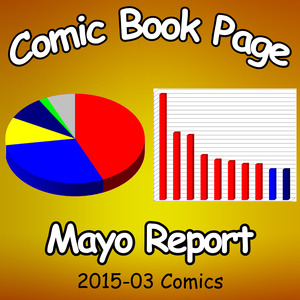Mayo Report for 2015-03

|

|
Top Comics List Top Comics Breakdown Top Trades List Top Trades Breakdown
March 2015 was a better month for Marvel than it was for DC. Marvel accounted for 47.17% of the total units for the top 300 comics while DC only accounted for 27.38%. Marvel dominated the top 20 with 14 of the slots while DC and Image only had three items each. Marvel had the top 8 slots with "Princess Leia" #1 topping the list at 253,655 estimated units. "Princess Leia" #2 dropped by over 62% but still was in fifth place with around 96,262 units. "Star Wars" #3 sold approximately 161,226 units after a 15% drop. "Spider-Gwen" #2 dropped over 57% down to 107,070 units while "Silk" #2 only dropped around 19% down to 69,369 units. While "Spider-Gwen" is outselling "Silk", "Silk" is retaining a higher percentage of sales than "Spider-Gwen."
Long time readers of my analysis might recall when I predicted "The Walking Dead" would eventually outsell "Spawn" at Image based on the way the two titles were trending. At the time, "Spawn" was outselling "The Walking Dead" but "Spawn" was trending down while "The Walking Dead" was trending up. Both title were long past the initial honeymoon period while both "Spider-Gwen" and "Silk" are only the second issues. The sales during the initial few months of a title are based on what retailers expect sales will be. After that honeymoon period, the retailers know how the title has or hasn't sold for them and can order much more accurately. It is too soon to know for sure which of the two titles will ultimately do better but the initial indications look more promising for "Silk" than for "Spider-Gwen."
With the Convergence event starting in April at DC and the Secret Wars event starting in Marvel at Marvel, March is the last "normal" month we might see for a little while. Both of those events involve displacing the regular line up at each publisher during the event with the promise of major shake ups afterwards. If you haven't read Brian Hibbs' article (http://www.comicbookresources.com/article/tilting-at-windmills-chaos-in-the-multiverse) last month on the challenges on ordering the Convergence and Secret Wars titles, I suggest you do so. He does a great job of explaining why these events are inherently risking for retailers and by extension, for the industry. Usually I have some general sense of what the top items are likely to be from month to month. Sometimes I get surprised by things like "Orphan Black" #1 or some other unexpected sales spike. (By the way, "Orphan Black" #2 sold around 10,652 units which is a drop of 97.86%. Unsurprisingly, it is the largest drop I have on record in my sales database.) I have no idea how sales for Convergence might stack up next month. Or the various Secret Wars titles the month after that. This could be a stressful couple of months for comic book retailers.
I'm a big fan of preordering comics. Not because I like the idea. I don't. But I like having a healthy comic book retailer community. By letting my retailer know during the ordering cycle what I'm planning on getting, it lets my retailer order accordingly. Hopefully that takes some of the stress out of the situation for all involved. If the store you shop at has a pull and hold service and you don't use it, you might want to consider doing so. It puts more information into the system on the reader side which hopefully helps out the retailers. Publishers can also help out by clearly indicating if a title is an ongoing title or a miniseries. I can't imagine DC wasn't planning from the outset for "Arkham Manor," "Klarion" and "Trinity of Sin" to be miniseries which ended with Convergence. Maybe "Klarion" could have been a surprise hit and could have continued beyond Convergence. The publisher should know if a title is going to be ongoing or not before it launches. There is no shame in announcing a miniseries has been successful enough to turn into an ongoing title. Withholding that piece of information from the retailers and readers, particularly right now with so much uncertainly around the line up at DC and Marvel, just seems like a bad idea.
With "Batman" #40 failing to ship in March, "Batman: Arkham Knights" #1 was the top selling DC title at 73,266 units. "Harley Quinn" #15 was the top selling New 52 title at 66,904 units. The only other DC title over 50,000 units in Marvel were "Detective Comics" #40, "Batman and Robin" #40 and "Superman #40. Generally speaking, sales at DC aren't that good right now.
With Convergence drawing a fairly clear line in the sand for the New 52 titles, it seems like a good time to see how the New 52 has worked out for DC. For the most part it is fairly clear what is and isn't part of the New 52 universe. There are a few titles such as "National Comics" and "Night Force" was are not as clearly in or out of the New 52 branding and continuity. Since "Night Force" as listed in the Beyond the New 52 section of the solicitations and nothing has placed it in the New 52 continuity, it is not being considered part of the New 52. "National Comics," on the other hand, was marketed as exploring some of the lesser known characters in the New 52 universe. Since Green Lantern appeared in "The Ray" which takes place in the same continuity as "Phantom Lady" and "Human Bomb," all of those titles are considered part of the New 52 as far as I'm concerned. Feel free to draw the lines however you’d like.
Here are two charts of what I'm considering as comprising the New 52 for the purposes of this discussion. The first has the titles in alphabetical order and the second in the order the titles launched. Each issue is listed at the intersection of the row for the title and the column for the release week. The "September events" are blocked off and the cells before a title launched and after it ended are shaded.
One thing of note with the chronological listing of the titles is lifespan of the New 52 titles. There have only been 10 one-shots and only 20 miniseries. Of the 20 miniseries, nine of them were published in the first year of the New 52, four of them were part of the Forever Evil event and three of them were the recent weekly miniseries. Overall, miniseries haven't worked out well in the New 52 as a way to launch new properties.
Overall the New 52 titles came out on time with three issues shipping slightly earlier than expected and 141 shipping later than expected and four items which were expected before Convergence have yet to be shipped. With 2,410 issues released, 145 late issues works out to around 6%. While not a perfect shipping track record, the majority of the line has shipped on time with only a handful of title plagued with delays. Some of those late items were due to delays with "Forever Evil" #7 which impacted other titles. The titles with the most shipping delays were "Superman Unchained," "Batman/Superman" and "Justice League."
Of the original New 52 titles, a dozen of them are continuing after the Convergence event: "Action Comics," "Aquaman," "Batgirl," "Batman," "Catwoman," "Detective Comics," "Flash," "Green Arrow," "Green Lantern," "Justice League," "Superman" and "Wonder Woman." "Red Hood and the Outlaws" seems to be getting replaced by "Red Hood/Arsenal" and "Starfire." Of the second wave of titles, only "Earth 2" and "Worlds' Finest" lasted beyond the Villains Month event in 2013. Those two remaining titles seem to be getting replaced by "Earth 2: Society" after Convergence. "Constantine" is getting replaced by "Constantine: The Hellblazer." A third of the two dozen titles returning after Convergence are less than a dozen issues old.
The unit sales for the DC titles in the top 300 have been averaging around 2,554,442 units with the New 52 titles accounting to an average of 2,182,536 of those units. The total for the top 300 is a bit better than the average of 2,283,613 units which DC had been doing prior to the New 52 launch. It is also a bit lower than the expectations of around 2,600,000 units I suggested back in October 2011, particularly since that suggested target was for just the New 52 titles, not all of the DC titles in the top 300. That having been said, the New 52 did bring a renewed interest in comic which benefited both DC and other publishers.
The average sales per item (ignoring August 2001 which had "Justice League" #1 as the only item) shows a slightly different picture. It indicates that sales are slipping with New 52 titles currently selling around 25,000 units on average. With the danger zone of cancellation somewhere between 10,000 and 20,000 units for a mainstream DC title, an average that low isn't healthy. Delays on high profile titles like "Superman Unchained" certainly didn't help the averages but the bottom line is many of the New 52 titles just don't sell that well.
Hopefully, DC's move to Burbank will break any old habits which no longer work and result DC editorial taking a fresh look at what the current comic book audience wants in a comic book. I remember prior to the New 52 launch being told by higher ups at DC how they we completely rethinking the storytelling style with the New 52 launch. Personally, I don't feel the storytelling was that different when the New 52 started. These days, I see titles like the recently retooled "Batgirl" title with each issues having a beginning, middle and end of a story while still telling multi-issue stories and it seem like someone over at DC gets it. Hopefully with the two dozen or so new titles after Convergence we'll see more titles focusing on each issue being worth buying in and of itself while still telling longer stories.




